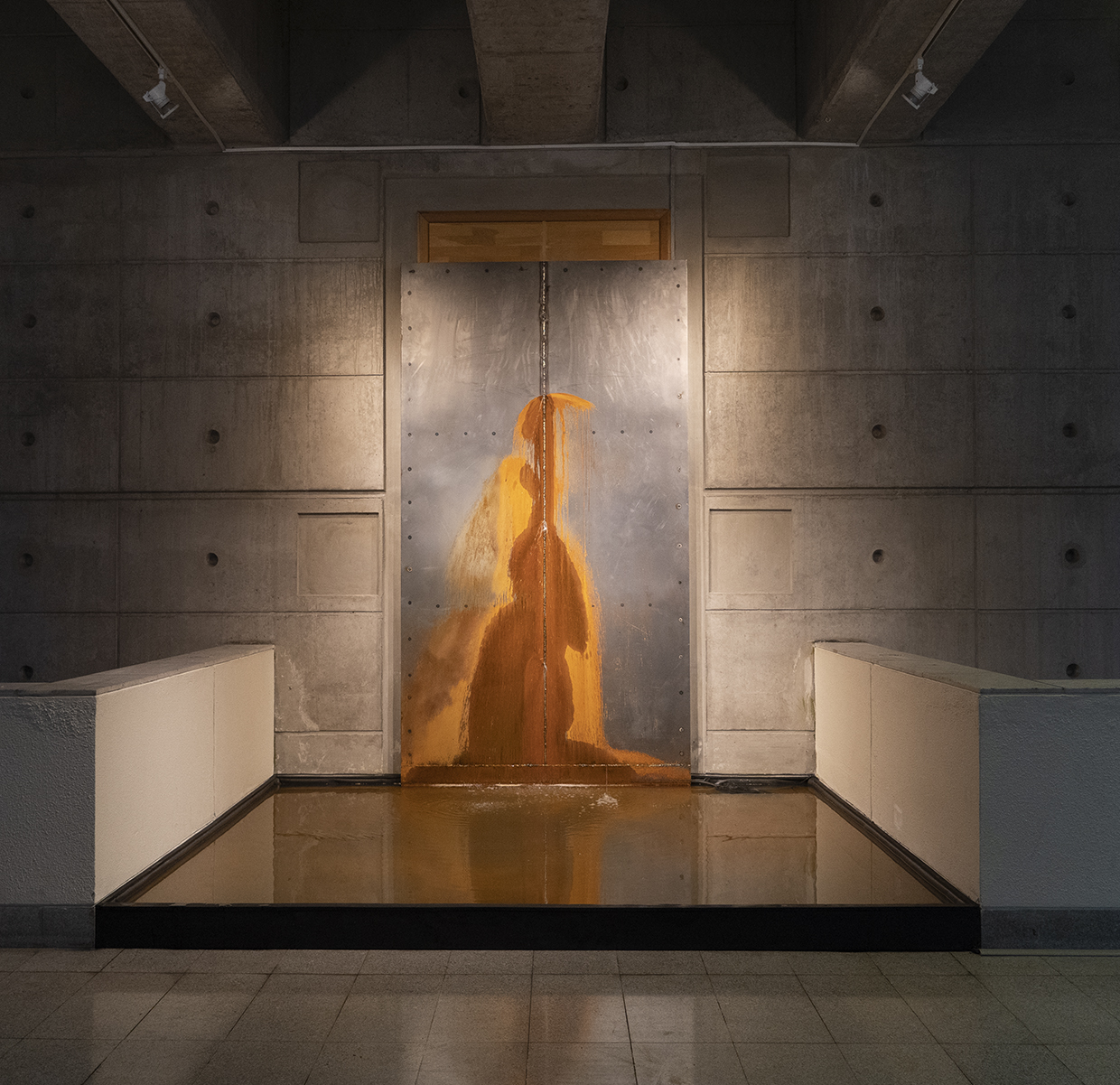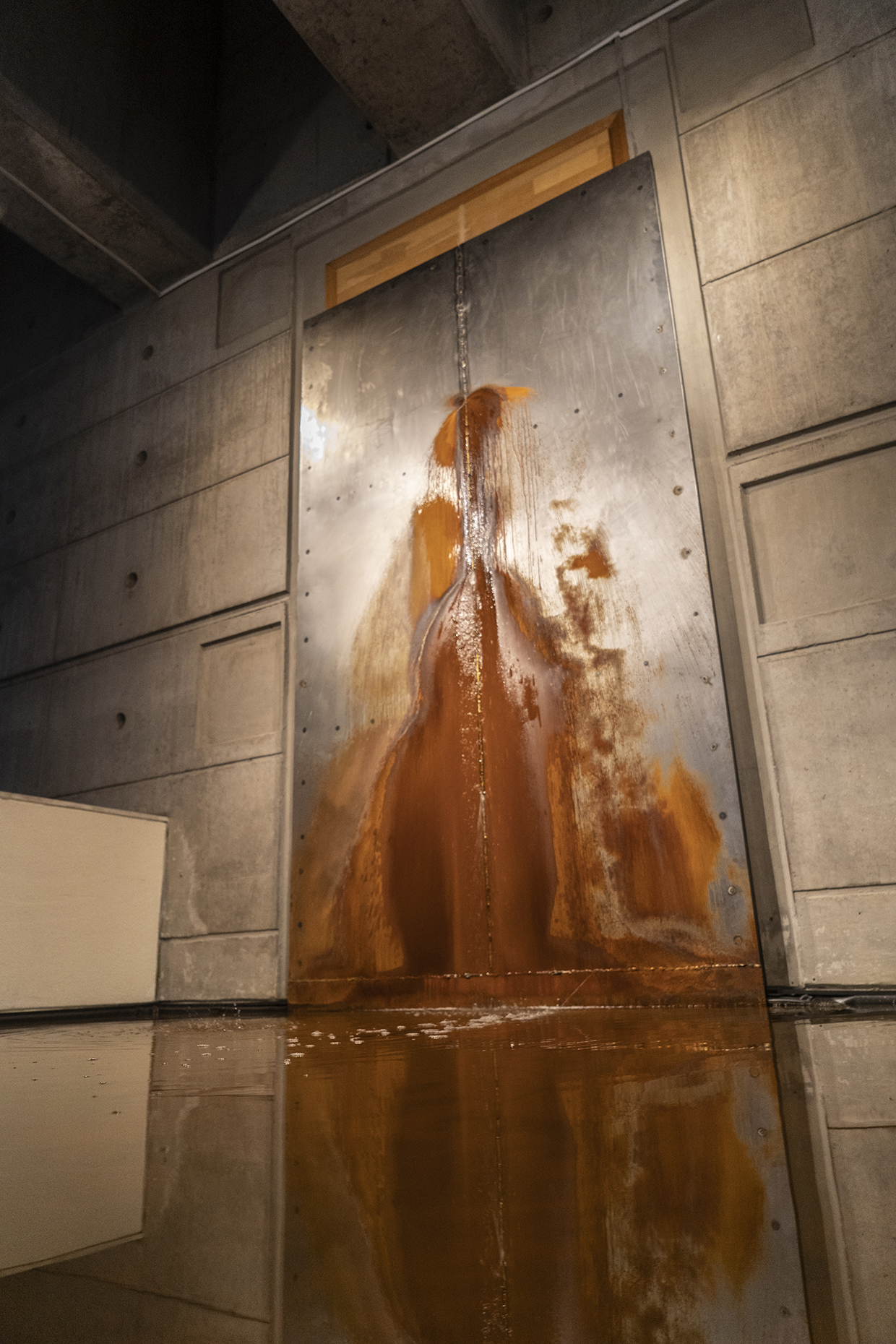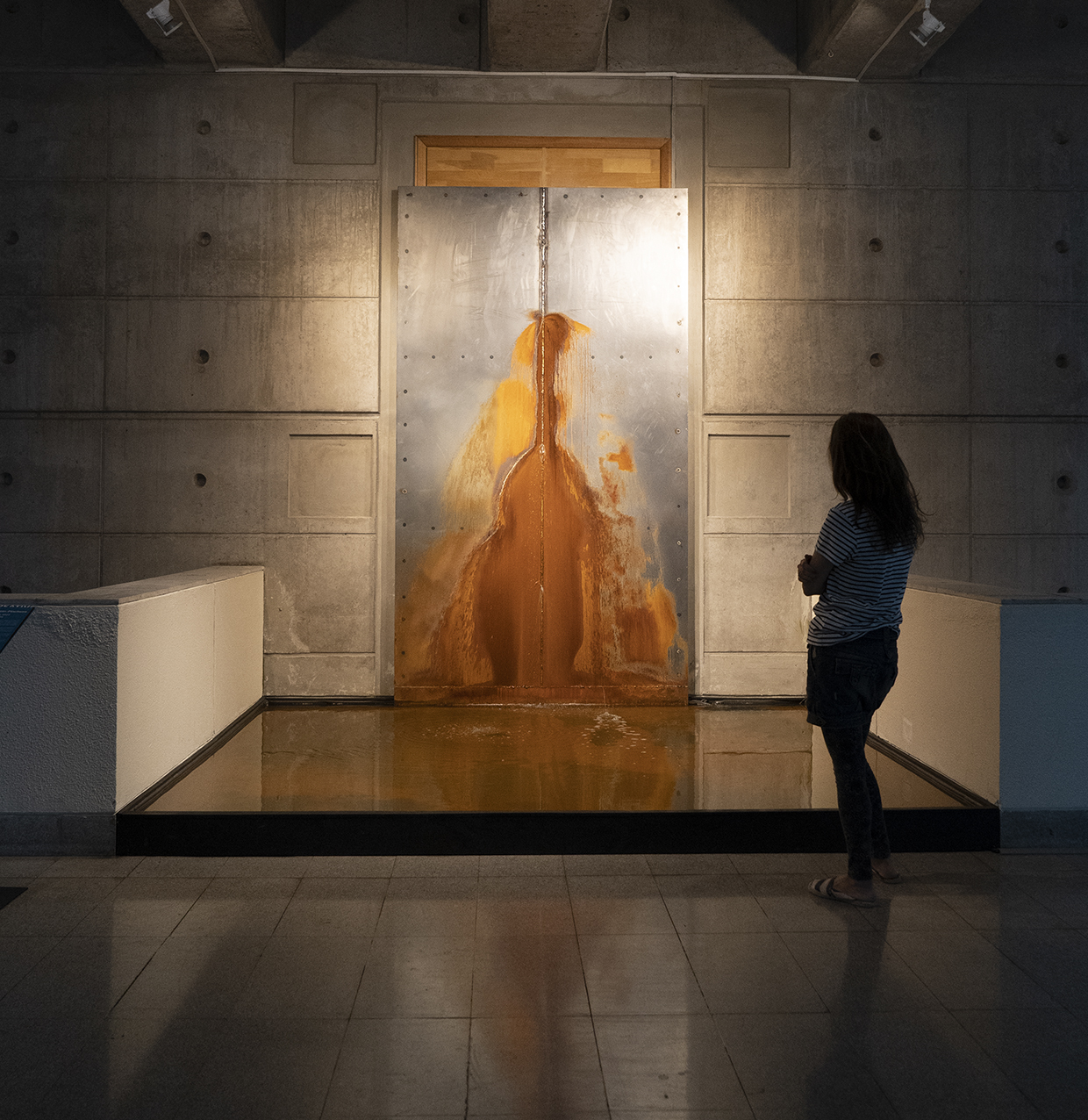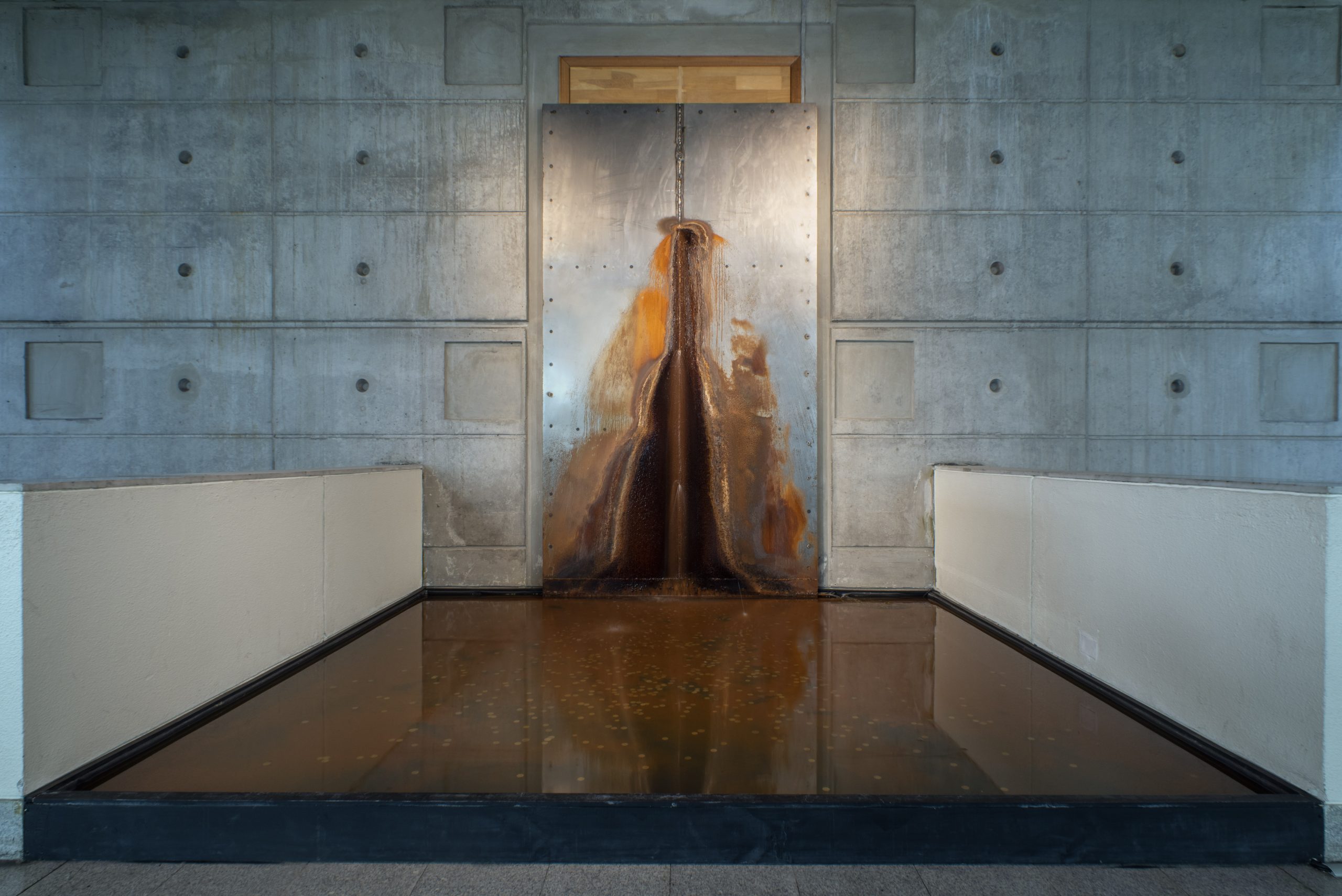2022. CENTRO CULTURAL LA MONEDA. SANTIAGO, CHILE.
Site specific
Intervention to an access that was apparently intended, in its initial design, to directly communicate the Presidential Palace with the La Moneda Cultural Center. The intervention consists of: an iron structure that blocks the door measuring 333cm x 173cm, a water tank measuring: 326cm x 287cm x 15cm high and a water pump.
Intervention of a specific site located in an access that is not used, which apparently was intended, in its initial design, to directly communicate the Presidential Palace with the La Moneda Cultural Center. The intervention consists of: an iron structure that blocks the door measuring 333cm x 173cm, a water tank measuring: 326cm x 287cm x 15cm high and a water pump.
Almost 50 years after the civic-military coup, the artist Máximo Corvalán-Pincheira makes Hacer agua: a site-specific installation that reflects on traumatic memory, unresolved justice and the flow of time. It is an intervention of steel plates mounted in front of a door that is permanently walled up and that supposedly gives direct access to the government palace. The steel plates, similar to those used by various business fronts during the last social revolt, allow a stream of water to filter through a joint that falls into a pool.
During his career, Corvalán-Pincheira has explored the relationship between state violence, memory, the fracture of the political system, and the climate crisis. From his own biography as the son of (a) disappeared person who was on that September 11, 1973 with President Salvador Allende in La Moneda, Hacer agua offers a visual reading that links the idea of a portico based on a trauma that determines two moments in history: the apparent forcing of permanent closure (of the past) and the need for temporary blocking after the violent irruption of the unresolved (of the present). The water that flows behind the cry of steel extends the viewer’s gaze towards the irrepressible cause of the country’s debt to the victims and their memory. Thus, the saying Making water –which we relate to the instability close to a flood– is reinforced in this case with the corrosion experienced by the steel precisely in the space of the crack. Said oxidation, in the fracture of the blockade intentionally placed in front of the bricked-up door “from and to” the government palace, exposes the impossibility of stopping the force of that moving memory despite the temporary reinforcements carried out over time. . In this sense, it is significant that water, an essential element where many bodies of detained-disappeared were thrown to make them disappear, including that of the artist’s own father, is the place of rebirth where he rests and re-emerges by means of a hydraulic pump. the water into the crack.
Hacer agua is an invitation to look from a critical perspective at the formulas with which we have built, in relation to one of the darkest and most painful moments, our past and present through a system of forces, elements and chemical reactions, which are They configure from the symbolic of power in the architecture of two spaces and two significant moments for the country.
Sebastian Vidal Valenzuela
Curator
—–
Site specific
Intervención a un acceso que aparentemente se pensó, en su diseño inicial, para comunicar directamente el Palacio Presidencial con el Centro Cultural la Moneda. La intervención consta de: una estructura de fierro que bloquea la puerta de 333cm x 173cm, estanque de agua de : 326cm x 287cm x 15cm de alto y bomba de agua.
A casi 50 años del Golpe cívico-militar, el artista Máximo Corvalán-Pincheira realiza Hacer agua: una instalación site-specific que reflexiona sobre la memoria traumática, la justicia irresuelta y el flujo del tiempo. Se trata de una intervención de planchas de acero montadas delante de una puerta tapiada de forma permanente y que supuestamente da acceso directo al palacio de gobierno. Las planchas de acero, similares a las que utilizaron diversos frontis de negocios durante la pasada revuelta social, dejan filtrar por una juntura un chorro de agua que cae a una pileta.
Durante su carrera Corvalán-Pincheira ha explorado la relación entre violencia del Estado, la memoria, la fractura del sistema político y la crisis climática. Desde su propia biografía como hijo de (un) desaparecido que estuvo aquel 11 de septiembre de 1973 junto al presidente Salvador Allende en La Moneda, Hacer agua ofrece una lectura visual que vincula la idea de pórtico en función de un trauma que determina dos momentos en la historia: el forzamiento aparente de clausura permanente (del pasado) y la necesidad de bloqueo temporal tras la irrupción violenta de lo irresuelto (del presente). El agua que fluye tras la grita del acero extiende la mirada del espectador hacia el cause irrefrenable de la deuda del país con las víctimas y su memoria. Así, el dicho Hacer agua –que relacionamos con la inestabilidad próxima a una inundación– se refuerza en este caso con la corrosión que experimenta el acero justamente en el espacio de la grieta. Dicha oxidación, en la fractura del bloqueo interpuesto intencionalmente delante de la puerta tapiada “desde y hacia” el palacio de gobierno, expone la imposibilidad de que la fuerza de esa memoria en movimiento sea detenida pese a los refuerzos temporales realizados a lo largo del tiempo. En este sentido, resulta significativo que el agua, elemento esencial en donde muchos cuerpos de detenidos desaparecidos fueron lanzados para hacerlos desaparecer, incluido el del propio padre del artista, sea el lugar de renacimiento donde reposa y vuelve a emerger por medio de una bomba hidráulica el agua hacia la grieta.
Hacer agua es una invitación a mirar desde una perspectiva crítica las fórmulas con las cuales hemos construido, en relación a uno de los momentos más oscuros y dolorosos, nuestro pasado y presente a través de un sistema de fuerzas, elementos y reacciones químicas, que se configuran desde lo simbólico del poder en la arquitectura de dos espacios y dos momentos significativos para el país.
Sebastián Vidal Valenzuela
Curador
—–




